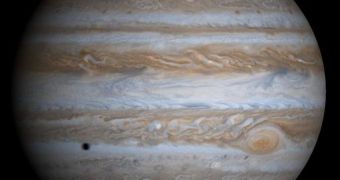A group of experts working in Atlanta, Georgia, are currently working on developing a comprehensive, highly-detailed model of the atmosphere surrounding the gas giant Jupiter. This study could reveal more details about how the planet – and indeed the solar system – formed.
The model that scientists hope to create will also provide astronomers with a reference frame against which to control the data that the NASA Juno spacecraft will be sending back 5 years from now.
Jupiter has a number of extremely interesting features that are visible in its atmosphere, such as for example bands of clouds swirling in opposite directions and a great red spot that has had astronomers confused since the first day they saw it.
The goal of the new experiments is to figure out what the atmosphere is made of, how the chemicals involved interact with each other and why. Given that Juno launched on August 5, the probe will not be able to answer these questions until mid-2016.
Experts are eagerly awaiting the result of observations conducted with the spacecraft's Microwave Radiometer (MWR) instrument, which is capable of piercing multiple layers of the Jovian atmosphere.
Current estimates show that the atmosphere surrounding the largest planet in our solar system is as much as 3,000 miles (5,000 kilometers) thick. The MWR will not reach the surface of the gas giant, but it will be able to provide data from deep within the clouds.
The reason why astronomers are so interested in Jupiter is because the object is most likely the first to form during the early days of the solar system, when the Sun itself was a lot different than it is today.
Until the MWR data become available, scientists here on Earth need to construct a reference frame. There is no way of doing that other than putting together a pressurized oven, and then mixing chemicals inside. The boiling mixtures are used to decipher the Jovian atmosphere.
“We can mix together different 'recipes' for the Jovian atmosphere and place them in our simulator,” Georgia Institute of Technology expert Paul Steffes tells Space. The researcher and his team are testing over 5,000 simulations of gas combinations.
All the results are inserted into a database. When the first MWR signals do arrive, experts will be able to compare them with the results they produced in Atlanta, and therefore figure out the chemical composition of the gas giant's atmosphere.
“The real question Juno MWR will address is the global inventory of water. This will be key to understanding the process by which Jupiter was formed,” Steffes explains.

 14 DAY TRIAL //
14 DAY TRIAL //